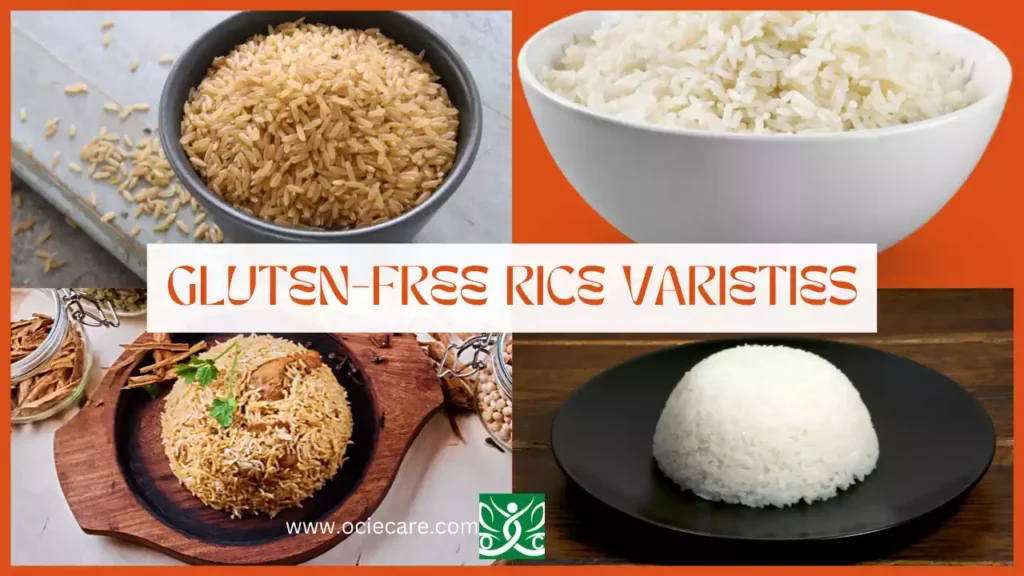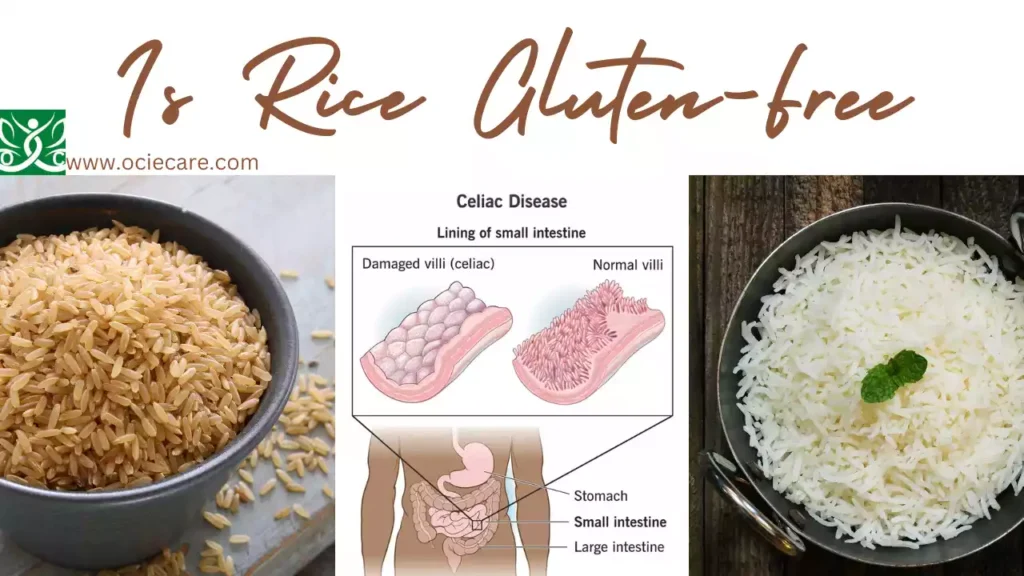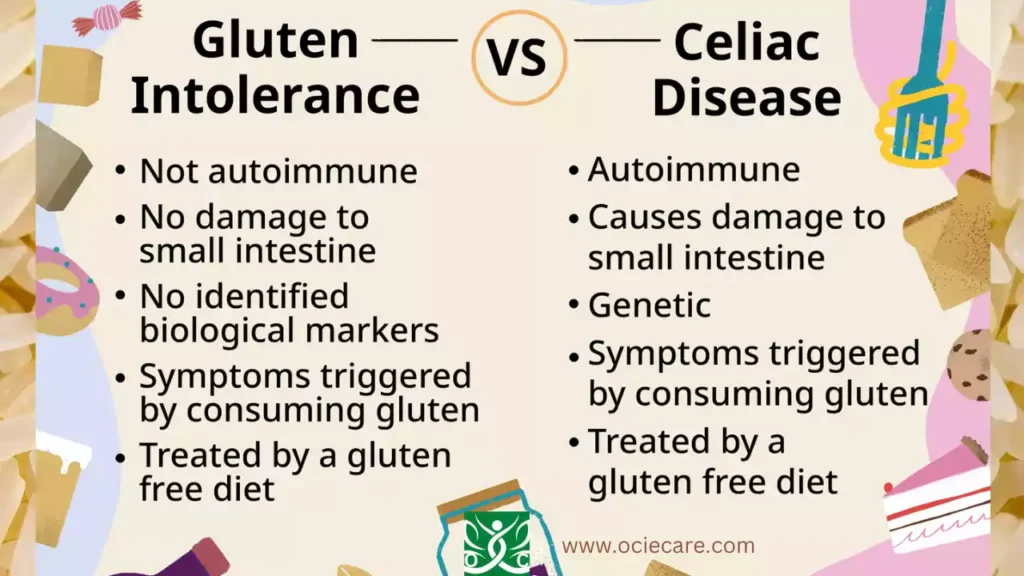One common question that often arises is, “Is rice gluten-free?”. In recent years, the gluten-free diet has gained immense popularity, with many individuals opting for gluten-free alternatives. Discover the gluten-free goodness of rice! Learn why rice, whether brown or white, is a safe and versatile choice for those with celiac disease or gluten sensitivity.
In this article, we will delve into the world of rice and explore whether it’s a safe option for those with gluten sensitivity or celiac disease. Explore the nutritional benefits and diverse culinary possibilities of this inherently gluten-free grain. Embrace a delicious and worry-free gluten-free lifestyle with rice as your go-to staple. Find answers to all your questions about the gluten-free status of rice right here!.
Is Rice Gluten-Free? : Understanding Gluten
Before we jump into the rice dilemma, let’s grasp the concept of gluten. Gluten is a protein found in wheat, barley, and rye. For individuals with celiac disease or gluten sensitivity, consuming gluten can lead to various health issues, ranging from digestive discomfort to more severe complications.
Let’s delve deeper into the concept of gluten and its impact on individuals with celiac disease or gluten sensitivity.
Gluten is a composite protein found in certain grains, notably wheat, barley, and rye. It acts as a binding agent, providing elasticity to dough and contributing to the chewy texture of many baked goods. While gluten is harmless for most people, it can pose significant health challenges for those with celiac disease or gluten sensitivity.
Celiac Disease:
- Celiac disease is an autoimmune disorder triggered by the ingestion of gluten in susceptible individuals. When someone with celiac disease consumes gluten, the immune system responds by attacking the small intestine. Over time, this immune response can damage the delicate lining of the intestine, leading to malabsorption of nutrients and a range of health issues.
- The consequences of gluten consumption for individuals with celiac disease extend beyond mere digestive discomfort. Chronic exposure to gluten in these individuals may result in nutritional deficiencies, weight loss, fatigue, and even long-term complications such as osteoporosis and neurological disorders.
Gluten Sensitivity:
- On the other hand, gluten sensitivity, also known as non-celiac gluten sensitivity, is a condition where individuals experience symptoms similar to those of celiac disease after consuming gluten. However, unlike celiac disease, gluten sensitivity does not involve an autoimmune response or the same level of intestinal damage.
- Symptoms of gluten sensitivity can vary widely and may include bloating, abdominal pain, fatigue, joint pain, and headaches. Although the mechanisms behind gluten sensitivity are not fully understood, avoiding gluten-containing foods is often recommended to alleviate symptoms.
For both individuals with celiac disease and those with gluten sensitivity, adopting a gluten-free diet is crucial to managing symptoms and preventing long-term health complications. Therefore, understanding the sources of gluten, such as wheat, barley, and rye, is essential in making informed dietary choices.
Now, armed with this knowledge, we can better appreciate why the gluten-free status of rice is a significant consideration for those seeking alternatives to traditional gluten-containing grains.
The Gluten-Free Status of Rice
Rice Basics
Rice stands as a fundamental dietary component for billions of people globally, playing a pivotal role as a primary source of carbohydrates. Its versatility and adaptability in various cuisines make it a dietary cornerstone for many cultures. From Asian stir-fries to Latin American rice and beans dishes, rice transcends borders, offering sustenance and energy to diverse populations.
The importance of rice in the human diet lies in its rich carbohydrate content. Carbohydrates serve as the body’s primary source of energy, fueling essential bodily functions and providing the necessary stamina for day-to-day activities. Rice, in its various forms, whether brown or white, serves as a convenient and accessible vehicle for delivering these crucial carbohydrates to people around the world.
The Crucial Question: Does Rice Contain Gluten?
Now, let’s address the critical inquiry: does rice contain gluten? The answer is a resounding no. Unlike wheat, barley, and rye—grains notorious for containing gluten—rice is inherently gluten-free. This quality makes rice an invaluable option for individuals with celiac disease or gluten sensitivity, as it allows them to enjoy a staple food without compromising their dietary restrictions.
As we explore the gluten-free nature of rice in the subsequent sections, it becomes evident that this grain not only satisfies hunger and provides essential energy but also caters to the needs of those who must adhere to gluten-free diets. The gluten-free status of rice enhances its appeal as a versatile and inclusive ingredient, making it a go-to choice for individuals with diverse dietary requirements.
Inherently Gluten-Free
The good news is that rice is inherently gluten-free. The reassuring news for individuals with gluten sensitivity or celiac disease is that rice is inherently gluten-free. In contrast to grains such as wheat, barley, and rye, rice lacks the presence of the troublesome gluten protein. This inherent quality makes rice a safe and nutritious option for those adhering to a gluten-free diet.
Why is Rice Gluten-Free?
- The gluten-free status of rice is attributed to its unique protein composition. Unlike wheat, barley, and rye, which contain gluten as a composite protein, rice is comprised of different proteins that do not include gluten. The absence of gluten in rice ensures that it does not pose a threat to individuals who must strictly avoid gluten due to health reasons.
Safety and Nutrition Combined
- Not only is rice a safe choice for those with gluten-related conditions, but it also contributes to a well-rounded and nutritious diet. As a rich source of carbohydrates, rice provides essential energy for bodily functions. Additionally, it contains vitamins and minerals that support overall health, making it a valuable component of diverse diets around the world.
Versatility in Gluten-Free Cooking
- The gluten-free nature of rice enhances its versatility in gluten-free cooking. Individuals following a gluten-free diet can confidently incorporate rice into various recipes, from main dishes to side dishes and desserts, without worrying about compromising their dietary restrictions.
In summary, the inherent gluten-free quality of rice makes it a reliable and inclusive choice for individuals seeking gluten-free alternatives. Whether you opt for the nutty and wholesome brown rice or the refined texture of white rice, rest assured that rice can be a staple in your gluten-free journey, offering not only safety but also nutritional benefits.
Celiac-Friendly Grain
Individuals diagnosed with celiac disease, an autoimmune disorder triggered by gluten consumption, can find solace in the fact that rice is a celiac-friendly grain. The absence of gluten in rice makes it a suitable and safe choice for those who face the challenges of adhering to a gluten-free lifestyle.
Understanding Celiac Disease:
- Celiac disease is a serious condition where the ingestion of gluten leads to an immune response that damages the small intestine. This can result in various health issues, including nutrient malabsorption and long-term complications. For individuals with celiac disease, strict adherence to a gluten-free diet is imperative to manage symptoms and prevent further damage to the intestine.
The Safety of Rice for Celiac Patients:
- Rice becomes a valuable ally for individuals with celiac disease due to its inherent gluten-free nature. This means that celiac patients can include rice in their diets without fear of triggering the adverse reactions associated with gluten consumption. Choosing gluten-free grains like rice helps individuals with celiac disease maintain a balanced and nutritious diet while avoiding the harmful effects of gluten on their health.
Versatility in Celiac-Friendly Cooking:
- The celiac-friendly status of rice extends beyond its safety—it also adds versatility to gluten-free cooking. Rice can be incorporated into a myriad of dishes, from savory meals to desserts, allowing those with celiac disease to enjoy a diverse and satisfying culinary experience without compromising their dietary restrictions.
In essence, rice serves as a beacon of relief for individuals diagnosed with celiac disease, offering a gluten-free alternative that not only meets their dietary needs but also opens the door to a world of delicious and safe culinary possibilities.
Exploring Gluten-Free Rice Varieties

Brown Rice
Brown rice is a wholesome choice for those seeking gluten-free and nutritionally dense options. What sets brown rice apart is its retention of the outer bran layer, which is rich in essential nutrients and fiber. This intact bran layer gives brown rice a nutty flavor and a chewy texture, making it not only a gluten-free alternative but also a nutritionally robust choice.
Key Features of Brown Rice:
Nutrient Retention:
- The outer layer of brown rice contains nutrients such as vitamins, minerals, and antioxidants. These nutrients contribute to overall health and well-being.
Fiber Content:
- Brown rice’s high fiber content supports digestive health and helps maintain stable blood sugar levels.
Satiety:
- The combination of fiber and nutrients in brown rice provides a sense of fullness, making it a satisfying and nourishing option for meals.
Choosing brown rice as a gluten-free alternative not only aligns with dietary restrictions but also adds a nutritional boost to your meals.
White Rice
White rice, although also gluten-free, undergoes a milling process that removes the outer bran layer, leaving behind the starchy endosperm. While this process results in a smoother texture, it does lead to a loss of some nutrients present in the bran. Despite this, white rice remains a safe and widely used alternative for those avoiding gluten.
Key Features of White Rice:
Gluten-Free:
- Like brown rice, white rice is inherently gluten-free, making it a suitable choice for individuals with gluten sensitivity or celiac disease.
Versatility:
- White rice’s neutral flavor and soft texture make it a versatile ingredient that can complement a wide range of dishes.
Easily Digestible:
- The removal of the bran makes white rice gentler on the digestive system, making it suitable for individuals with sensitive stomachs.
In summary, both brown and white rice offer gluten-free options for individuals with dietary restrictions. Brown rice stands out for its additional nutritional benefits, while white rice provides a versatile and easily digestible alternative. The choice between the two depends on individual preferences and nutritional priorities.
Gluten-Free Foods
There are tons of delicious and nutritious gluten-free options to choose from! To make it easier, let’s break it down by category:
Naturally Gluten-Free:
Fruits and Vegetables:
- All fresh produce is naturally gluten-free, so load up on fruits, vegetables, and leafy greens for vitamins, minerals, and fiber.
Protein:
- Fresh meat, poultry, fish, seafood, eggs, and dairy products are naturally free of gluten, making them excellent sources of protein and essential nutrients.
Beans, Legumes, and Nuts:
- Beans, lentils, chickpeas, peanuts, almonds, and other nuts are naturally gluten-free and offer great sources of protein, fiber, and healthy fats.
Grains and Starches:
- Opt for naturally gluten-free grains like quinoa, brown rice, wild rice, buckwheat, sorghum, millet, amaranth, teff, and arrowroot. They provide complex carbohydrates, fiber, and essential nutrients.
Processed Gluten-Free Options:
Gluten-Free Flours:
- Rice flour, almond flour, coconut flour, oat flour (labeled gluten-free), and chickpea flour are some popular choices for baking and cooking gluten-free.
Gluten-Free Breads and Pastas:
- Many brands offer gluten-free versions of bread, pasta, and even crackers. Look for options made with whole grains like brown rice or quinoa for added nutrition.
Packaged Snacks and Cereals:
- There are plenty of gluten-free snacks and cereals available, but be sure to check the labels for added sugars and unhealthy fats. Look for options with simple ingredients and whole grains.
Tips for Choosing Gluten-Free Foods:
Read labels carefully:
- Always check the ingredient list and food label for any hidden gluten sources, like wheat derivatives, barley malt, or modified food starch.
Look for the Certified Gluten-Free label:
- This symbol assures that the food meets strict gluten-free standards.
Choose whole foods over processed options:
- While pre-packaged gluten-free products can be convenient, focusing on whole, unprocessed foods is generally healthier and more nutritious.
Get creative in the kitchen:
- There are endless possibilities for delicious and nutritious gluten-free meals and snacks. Explore new recipes and ingredients to expand your gluten-free repertoire.
Remember, following a gluten-free diet doesn’t have to be restrictive! With a little planning and creative thinking, you can easily enjoy a healthy and delicious variety of gluten-free foods.
Conclusion
In conclusion, the question “Is rice gluten-free?” can be unequivocally answered in the affirmative. Rice, whether in the form of brown or white varieties, is inherently gluten-free, making it a safe and versatile option for individuals with celiac disease or gluten sensitivity.
The gluten-free nature of rice extends beyond a mere absence of the troublesome protein. It positions rice as a staple that not only caters to dietary restrictions but also offers nutritional benefits. Brown rice, with its intact bran layer, provides essential nutrients and fiber, contributing to a wholesome and nutritious diet. On the other hand, white rice, while undergoing a milling process that removes some nutrients, remains a convenient and easily digestible gluten-free alternative.
For those navigating the challenges of a gluten-free lifestyle, rice becomes a celiac-friendly grain, offering a sigh of relief and a diverse range of culinary possibilities. Whether you prefer the earthy richness of brown rice or the versatility of white rice, both varieties contribute to a balanced and satisfying gluten-free diet.
In essence, rice stands as a beacon of assurance for individuals seeking gluten-free alternatives, providing not only safety but also the potential for culinary creativity and nutritional well-being.
FAQs
Q. Is rice gluten-free?
A. Yes, rice is inherently gluten-free. It does not contain the gluten protein found in wheat, barley, and rye.
Q. Can individuals with celiac disease eat rice?
A. Absolutely. Rice is a celiac-friendly grain, making it a safe and nutritious choice for individuals with celiac disease.
Q. What makes brown rice gluten-free?
A. Brown rice is gluten-free because it retains its outer bran layer, which is rich in essential nutrients and fiber.
Q. Is white rice gluten-free?
A. Yes, white rice is also gluten-free. Although it undergoes a milling process that removes the bran layer, it remains safe for those avoiding gluten.
Q. Are there gluten-free rice varieties other than brown and white rice?
A. Yes, various gluten-free rice varieties include jasmine rice, basmati rice, and wild rice.
Q. Can rice be a part of a gluten-free diet plan?
A. Absolutely. Rice is a versatile and nutritious component of a gluten-free diet, providing essential carbohydrates and serving as a staple food for many cultures.
Q. Are rice-based products gluten-free?
A. Generally, rice-based products like rice flour and rice noodles are gluten-free. However, it’s essential to check labels for any potential gluten-containing additives.
Q. Is there a risk of cross-contamination with gluten in rice products?
A. While rice itself is gluten-free, there may be a risk of cross-contamination during processing. Choosing certified gluten-free rice products can help minimize this risk.
Q. Can rice be used as a substitute for gluten-containing grains in recipes?
A. Yes, rice can be an excellent substitute in gluten-free recipes, offering a neutral flavor and adaptable texture in various dishes.
Q. Are there any rice dishes that may contain gluten?
A. Some rice dishes, such as those prepared with soy sauce or certain seasonings, may contain gluten. It’s crucial to be mindful of ingredients and opt for gluten-free alternatives when necessary.
You may also like to read:
- Pegan Diet Food List | 62+ Food | Secrets of Vibrant Health and Wholesome Vitality!
- Factors Affecting Meal Planning | Embrace Secrets Of Wellness, and Joy! In 2023
- Green Mediterranean Diet | A Culinary Journey to Optimal Health In 2023
- Intermittent Fasting Diet Plan Indian | Secrets For A Healthier Future In 2023

